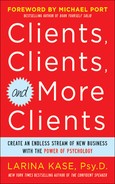Use Social Proof to Resolve Ambivalence or Objections
,Another powerful use of social proof is to address concerns that potential clients or referral partners may have about working with you.
Lessons from long distance drives
One day a client, a busy marketing executive who lived in Delaware, arrived at my office in Philadelphia in a state of irritation. The drive from Wilmington, Delaware, to my office typically takes around one hour but can take longer depending on traffic.
“Are you okay? What’s bothering you today?” I asked her.
“It’s no big deal, I’ll be fine,” she told me.
“You don’t have to tell me, but I can see that something is upsetting you, and perhaps we could address it quickly and then move on,” I suggested.
She told me, “It took me so long to get here today and I have so much to do. No offense, it’s not that you’re not worth driving all of this way, but it just takes up a lot of time.”
“I know, and the traffic on 76 can be horrible, can’t it? I have many clients who drive from Delaware and many from New Jersey, and the drive varies so much based on traffic, it’s quite frustrating,” I said.
“Yeah,” my client said, and her mood brightened. “Now, for what we were going to work on today …”
Why did her mood shift?
Well, the first and more obvious reason is that she felt empathized with and validated in her frustration. The second and less obvious reason—which you may have guessed now that you know how social proof works—was that she felt better to know that others were doing the same thing she does. Think about it: if you were the only one to drive a long distance to an appointment, you would ask yourself, “Why am I doing this?” Whereas if you knew that others also drove a long distance, you might think, “Well, there’s a reason that people are willing to drive so far; I’m in good hands.” I learned that I should have directly addressed this concern up front because it could have prevented her from becoming a client, and the social proof that she was not alone in a long commute could have prevented her from becoming frustrated.
Allow others to address ambivalence
Let’s say, for example, that you’re a financial advisor and you’re only 26 years old. You use the ideas you’ve learned in this book and create some strong business relationships. You could then ask someone who you feel comfortable asking for feedback, “When I first approached you, what made you unsure about working with me?” That person might say, “Well, you just looked and sounded so young.” You could respond, “Could you write me a brief endorsement beginning with how you were initially unsure about me because of that?”
When people address the initial skepticism they experienced (and of course the positive result that occurred when they got past it), you have a very powerful form of social proof because others are likely to share the same concerns and be relieved and happy to know that if they put those concerns aside (or address them directly with you), they could receive great benefit from your work together.
Q&A
Another way to address potential concerns about hiring you or referring to you is with a list of common questions and answers. The key to doing this effectively is to know what people’s real concerns are rather than making assumptions. You can find out concerns by speaking with people who share the same target market and learning more about the needs of their clients. Let say that you’re a graphic designer and your target audience is owners of restaurants. You speak with Web designers, small business accountants, or others who work with restaurant owners and learn more about them. You find out that their biggest challenge is time. One question in your Q&A might be:
Q: How long will it take from start to finish of my postcard mailings?
A: We pride ourselves on our fast turnaround time and offer your initial proofs within two business days. Most of our clients receive their final materials within five days and are able to send out a mailing within one week of engaging our services.
Or let’s say that you’re a motivational speaker and you know from meeting planners that they want to be sure that those in their audience walk away with tangible things they can do differently, not just good feelings. A question in your Q&A might be:
Q: Are your talks purely motivational?
A: My style is a combination of motivational and practical. Audience members have called my presentations “inspiring” and also “filled with practical action steps.”
